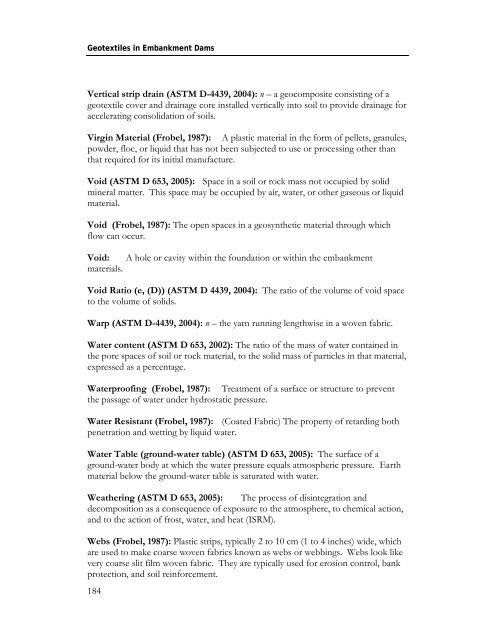Geotextiles in Embankment Dams - Association of State Dam Safety ...
Geotextiles in Embankment Dams - Association of State Dam Safety ...
Geotextiles in Embankment Dams - Association of State Dam Safety ...
Create successful ePaper yourself
Turn your PDF publications into a flip-book with our unique Google optimized e-Paper software.
<strong>Geotextiles</strong> <strong>in</strong> <strong>Embankment</strong> <strong><strong>Dam</strong>s</strong>Vertical strip dra<strong>in</strong> (ASTM D-4439, 2004): n – a geocomposite consist<strong>in</strong>g <strong>of</strong> ageotextile cover and dra<strong>in</strong>age core <strong>in</strong>stalled vertically <strong>in</strong>to soil to provide dra<strong>in</strong>age foraccelerat<strong>in</strong>g consolidation <strong>of</strong> soils.Virg<strong>in</strong> Material (Frobel, 1987): A plastic material <strong>in</strong> the form <strong>of</strong> pellets, granules,powder, floc, or liquid that has not been subjected to use or process<strong>in</strong>g other thanthat required for its <strong>in</strong>itial manufacture.Void (ASTM D 653, 2005): Space <strong>in</strong> a soil or rock mass not occupied by solidm<strong>in</strong>eral matter. This space may be occupied by air, water, or other gaseous or liquidmaterial.Void (Frobel, 1987): The open spaces <strong>in</strong> a geosynthetic material through whichflow can occur.Void: A hole or cavity with<strong>in</strong> the foundation or with<strong>in</strong> the embankmentmaterials.Void Ratio (e, (D)) (ASTM D 4439, 2004): The ratio <strong>of</strong> the volume <strong>of</strong> void spaceto the volume <strong>of</strong> solids.Warp (ASTM D-4439, 2004): n – the yarn runn<strong>in</strong>g lengthwise <strong>in</strong> a woven fabric.Water content (ASTM D 653, 2002): The ratio <strong>of</strong> the mass <strong>of</strong> water conta<strong>in</strong>ed <strong>in</strong>the pore spaces <strong>of</strong> soil or rock material, to the solid mass <strong>of</strong> particles <strong>in</strong> that material,expressed as a percentage.Waterpro<strong>of</strong><strong>in</strong>g (Frobel, 1987): Treatment <strong>of</strong> a surface or structure to preventthe passage <strong>of</strong> water under hydrostatic pressure.Water Resistant (Frobel, 1987): (Coated Fabric) The property <strong>of</strong> retard<strong>in</strong>g bothpenetration and wett<strong>in</strong>g by liquid water.Water Table (ground-water table) (ASTM D 653, 2005): The surface <strong>of</strong> aground-water body at which the water pressure equals atmospheric pressure. Earthmaterial below the ground-water table is saturated with water.Weather<strong>in</strong>g (ASTM D 653, 2005): The process <strong>of</strong> dis<strong>in</strong>tegration anddecomposition as a consequence <strong>of</strong> exposure to the atmosphere, to chemical action,and to the action <strong>of</strong> frost, water, and heat (ISRM).Webs (Frobel, 1987): Plastic strips, typically 2 to 10 cm (1 to 4 <strong>in</strong>ches) wide, whichare used to make coarse woven fabrics known as webs or webb<strong>in</strong>gs. Webs look likevery coarse slit film woven fabric. They are typically used for erosion control, bankprotection, and soil re<strong>in</strong>forcement.184
















